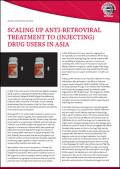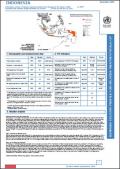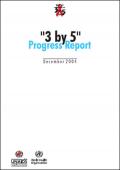What's New
Displaying results 4571 - 4580 of 4914

Resource | Publications,
Integrated Biologic (HIV/STI) and Behavioural Surveillance surveys were carried out from March to August 2004 in Lahore and Karachi in the following high-risk groups: injecting drug users, female sex workers, male sex workers, hijras (transgenders) and truckers. Sample sizes were 400 in each group at each site except for hijras, for whom the sample size was 200 at each site.

Resource | Publications,
In 2004, the National Epidemiology Center of the Department of Health and Family Health International undertook an evaluation of the current HIV surveillance system and made recommendations for adopting new methodologies and questionnaires to improve the capacity of the system to detect emerging localized epidemics and measure behaviors that put populations at risk for HIV transmission. The recommendations were accepted and the revised Integrated HIV Behavioral and Serologic Surveillance (IHBSS) system was implemented in 2005.

Resource | Publications,
The National AIDS Spending Assessment aims to assess the situation of the actual National expenditures on HIV/AIDS activities over the last five years (2000-2004) from different institutions. The total AIDS expenditure over the past five years is estimated at Lao Kip 148.62 billion (USD 14.85 million). The expenditure trend has shown the steadily increase steadily every year from 2.1 million in 2000 to 4.99 million in 2004. There were two sources of National AIDS Spending, from the government (in kind see table 2), and from external assistant. Remarkably, a large spending of AIDS came from external sources of 98.83 percent to 99.83 percent.

Resource | Publications,
The HIV/AIDS situation in the country can be described as hidden and growing. Based on the HIV/AIDS Registry of the National Epidemiology Center (NEC) of the Department of Health (DOH), the cumulative number of HIV/Ab seropositive cases has reached 2,373 since 1984. Epidemiologists and experts, however, estimate that the actual number of HIV cases is around 10,000. Despite the increasing number of cases, the prevalence rate remains consistently below one percent.
An examination of the country's total HIV/AIDS spending over the last five years (2000-20004) showed an erratic trend, peaking in 2001, and declining in the years that followed. Notably, a large share of total annual spending came from external sources (at least 75 percent).
The Philippines is committed to halting and reversing the spread of HIV/AIDS. Hence, mobilization of resources is critical in keeping the prevalence of HIV/AIDS low and the rate of transmission slow.

Resource | Fact Sheets,
Violence against women and girls is a global pandemic of alarming proportions, deeply rooted in gender inequality and discrimination. No woman or girl is entirely free of its risks or reach. It takes many forms and occurs in many places — domestic violence in the home; sexual abuse of girls in schools; sexual harassment at work and in public spaces; abuse during pregnancy; and rape in cities and in rural areas, in refugee camps and as a tactic of war. It includes harmful practices such as female genital mutilation/cutting, child and forced marriage, so-called 'honour' killings, acid attacks and dowry-related abuse; as well as newer forms, such as cyber-bullying and e-stalking via the internet and mobile phones. This fact sheet documents the scale of the pandemic.

Resource | Publications,
Although anti-retroviral treatment (ART) is not traditionally considered a central concern in the harm reduction agenda, from a global public health perspective, Asian Harm Reduction Network (AHRN) believes that ART remains a very important service within a comprehensive HIV/AIDS treatment and care model. As such, AHRN’s analysis and experience in national, regional or international initiatives which have operational goals determined and evaluated through the provision of anti-retroviral (ARV) medications to people living with HIV/AIDS (PLWHA), demonstrates that we should applaud such treatment services on the principle that all people, regardless of ethnicity, religion, gender or sexual orientation, should receive quality treatment and health care.

Resource | Publications,
Indonesia's health system is highly decentralized; provincial and district health services have significant autonomy to determine policies, priorities and financing. However, the major source for the national budget for HIV/AIDS is the Global Fund to Fight AIDS, Tuberculosis and Malaria, through which activities in 17 provinces are supported. In 1994, the National AIDS Commission was established as a secretariat to coordinate the multisectoral approach. Provincial AIDS commissions have been established in every province, headed by the vice-governor. Local initiatives for antiretroviral therapy have been launched throughout Indonesia, under the commitment of local authorities and of physicians taking care of people living with HIV/AIDS. The National HIV/AIDS Strategy for 2003–2007 identifies the following programme priorities – HIV/AIDS prevention, care and treatment and support for people living with HIV/AIDS, surveillance, operational research, multisectoral coordination and a sustainable response.

Resource | Publications,
In an effort to keep abreast of rapid changes in the landscape of the HIV pandemic, WHO and UNAIDS
report semiannually on progress toward "3 by 5". The first update was presented at the XV International AIDS Conference in Bangkok, Thailand, in July 2004.
This second report measures progress made by countries and describes how international partners are
supporting their efforts. In addition, it summarizes how the building blocks of antiretroviral (ARV) therapy programmes are being put into place and how issues beyond treatment are being addressed.
It provides examples of country progress and a global estimate of the number of people receiving ARV therapy, and it assesses how well the therapy is working. It also identifi es some of the challenges faced in resource-constrained settings and how these are being met by improving health care systems, links between prevention and treatment and providing equal access to quality care.

Resource | Publications,
China has a low overall HIV prevalence but high prevalence in certain population groups and at some sites. WHO/UNAIDS estimated that 840,000 people in 0–49 years old were living with HIV/AIDS at the end of 2004, and the estimated HIV prevalence was 0.07% (with a low estimate of 0.05% and a high estimate of 0.08%). There are geographical differences in prevalence levels within sub-populations. Since 2001, reported HIV/AIDS cases have increased at a 30% annual rate, most likely as a result of increased surveillance. HIV is reported from 31 of China’s 34 provinces and other administrative units on mainland China.

Resource | Publications,
India’s population surpassed 1 billion in 2001; 67% live in rural areas and 33% in urban areas. India is estimated to have the second largest population of people living with HIV/AIDS, next to South Africa. An estimated 5.13 million individuals currently live with HIV across all states in India. In areas that are more severely affected, the epidemic has started to challenge recent development achievements and to raise fundamental issues of human rights concerning people living with HIV/AIDS.





